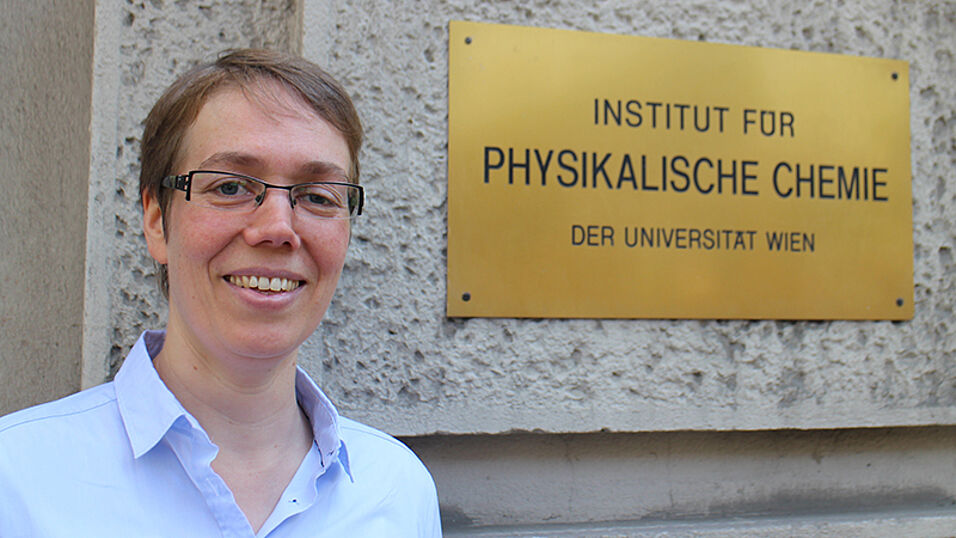„Mich interessieren vor allem die molekularen Strukturen und das Verhalten von Molekülen an Grenzflächen – ob bei Wasser, Tensiden, Lipiden oder Polymeren. Mein Forschungsschwerpunkt liegt im Bereich Wasser an Grenzflächen und ist u.a. für das Verständnis chemischer Reaktionen an Wassertröpfchen in der Atmosphäre und elektrochemischer Prozesse wichtig. Dieser Schwerpunkt ist teilweise auch historisch begründet“, erzählt die Physikochemikerin.
Am Max-Planck-Institut für Polymerforschung in Mainz, wo sie seit 2012 tätig war, hat sich ihre Arbeitsgruppe von Anfang an mit Wasser an Grenzflächen beschäftigt. Als Gruppenleiterin untersuchte sie vor allem die Struktur und Dynamik von Wasser an Grenzflächen mittels Oberflächenspektroskopie. 2013 erhielt sie für ihr Projekt über Grundlagen zur photokatalytischen Wasserspaltung (Fundamentals of photocatalytic splitting of water) einen prestigeträchtigen ERC Starting Grant des Europäischen Forschungsrates. Diesen bringt sie an die Universität Wien mit; die Förderung läuft bis 2019.
Übergeordnetes Ziel: "Effiziente Energiequellen zu finden"
In ihrem ERC-Projekt thematisiert sie ein wichtiges Zukunftsthema: In Wasserstoff als emissionsfrei geltender Kraftstoff werden große Hoffnungen gesetzt. Als Kraftstoff für Brennstoffzellen wird er bereits genutzt. Doch, das ist die Crux, seine Produktion gilt als relativ umweltbelastend und kostenintensiv.
„Auch in unserer Forschung ist es ein übergeordnetes Ziel, neue, ökologisch saubere und effiziente Energiequellen zu finden“, sagt Backus. Die photokatalytische Wasserspaltung besitze hier großes Potenzial. Aber der Prozess, bei dem mit Hilfe von Photonen (Sonnenstrahlung) und unter Einsatz eines Katalysators Wasser in Wasserstoff und Sauerstoff aufgespalten wird, ist in seinen Grundzügen noch kaum verstanden. Bereits jetzt über weitere Anwendungen nachzudenken, wäre Backus zufolge viel zu früh.
Reaktion von Wassermolekülen beobachten
„Dass man Wasserstoff an Grenzflächen mit einem Katalysator und unter Bestrahlung mit Sonnenenergie spalten kann, ist schon länger bekannt. Wir wissen aber kaum, was dabei auf molekularer Ebene passiert. Das wollen wir herausfinden.“ Was ist der genaue Reaktionsweg vom Wasser zum Wasserstoff? Wie verhalten sich die Moleküle bei Bestrahlung, wie drehen sie sich, wie interagieren sie, welche Zwischenprodukte entstehen? Wie entsteht der Wasserstoff? Ellen Backus nutzt für ihre Grundlagenforschung Titanoxid als Katalysator. Das Titanoxid aktiviert sie mit Laserpulsen und beobachtet ihre Reaktion an den Grenzflächen über die Zeit mit Oberflächenschwingungsspektroskopie.
„Um effiziente Katalysatoren für die Spaltung von Wasser zu gewinnen, müssen wir erst einmal verstehen, was an Grenzflächen auf molekularer Skala vor sich geht. Dieses Verständnis könnte dann helfen, bessere Katalysatoren für die photokatalytische Wasserspaltung zu entwickeln“, so Backus.
Standort Wien - „ist alles neu“
Die Physikochemikerin steigt im Wintersemester mit einer Master-Vorlesung zu Wechselwirkungen von weicher und fester Materie an Grenzflächen in die Lehre ein. Sie freut sich zudem auf die vielfältigen Anknüpfungspunkte in der Forschung mit den anderen Instituten der Fakultät für Chemie, etwa im Bereich der Katalyse (z.B. in der Entwicklung von Katalysatoren), der analytischen Chemie (im Erfassen der Struktur der Moleküle) und der Biophysik. Auch ihre Forschung zur Struktur von Eis an Grenzflächen möchte sie in Wien weiter betreiben und könnte sich hier Kooperationen mit der Physik vorstellen.
Abgesehen von ihren Forschungsschwerpunkten: „Wien ist für mich ganz neu. Ich hatte bisher keine Forschungskooperationen mit Wiener Kolleginnen und Kollegen und habe auch noch nie längere Zeit in Wien verbracht. Aber es ist eine sehr schöne Stadt! Und ich habe in Österreich auch schon häufiger Urlaub gemacht“, lacht Backus, die den Weg von ihrer Wohnung bis zur Uni natürlich mit dem Fahrrad absolviert. Willkommen an der Fakultät für Chemie!
- Zur Person: Ellen Backus, geb. 1978, studierte Chemie an der Universität Amsterdam und absolvierte ihre Doktorarbeit an der Universität Leiden. Als Post-doc war sie an der Universität Zürich, dann am FOM-Institute AMOLF in Amsterdam und seit 2012 als Gruppenleiterin am Max-Planck-Institut für Polymerforschung in Mainz tätig. 2013 erhielt sie einen ERC Starting Grant. Sie ist „Professor by special appointment of Non-Linear Spectroscopy of Surfaces and Interfaces“ an der Universität Amsterdam und seit 1. Oktober 2018 Professorin für Physikalische Chemie an der Universität Wien.

